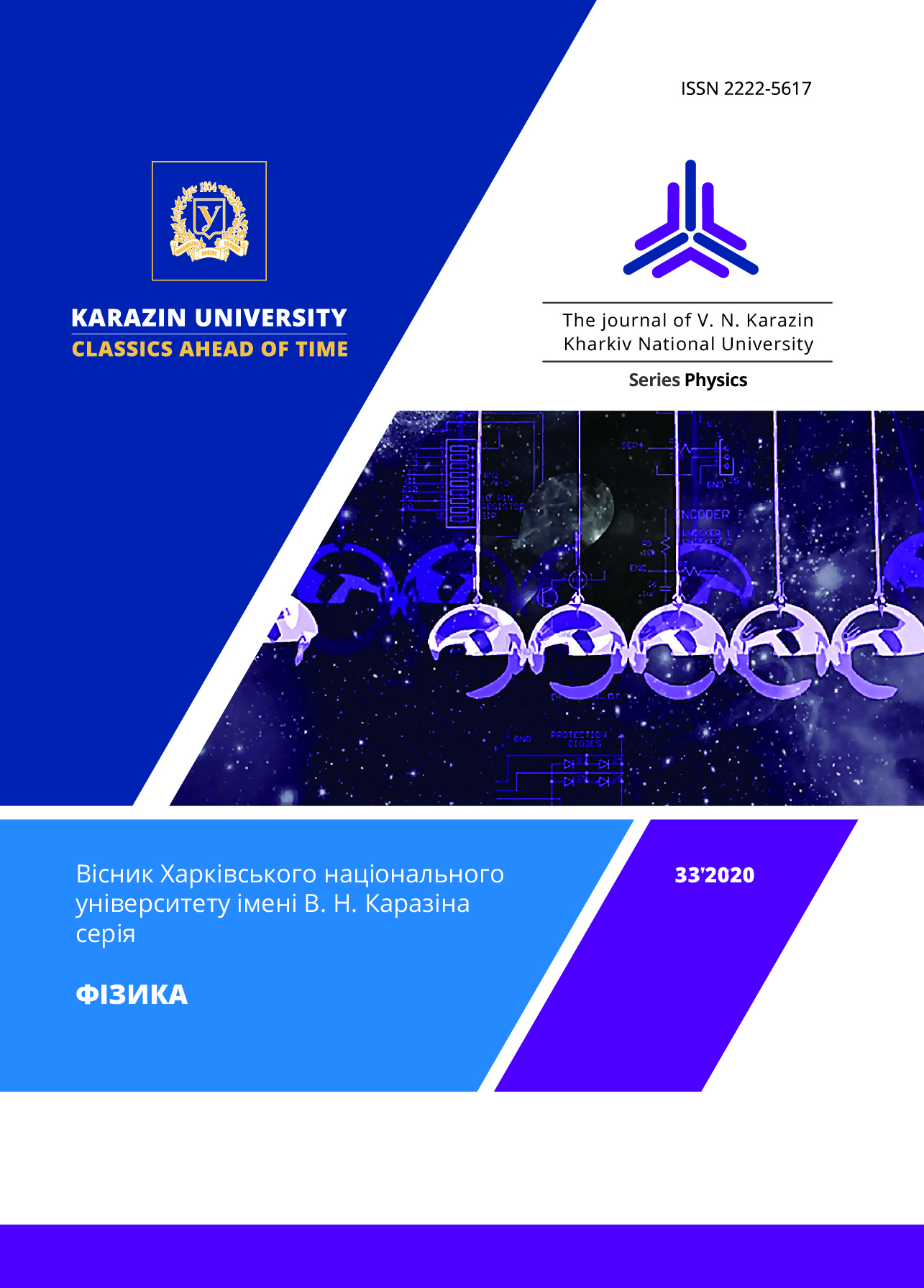Вплив тиску на електричний опір монокристалів Y0.77Pr0.23Ba2Cu3O7-δ
Анотація
Досліджено вплив гідростатичного тиску до 12 кбар на електричний опір в базисної ab-площині оптимально допованих киснем (δ <0.1) монокристалів Y1–xPrxBa2Cu3O7–δ, помірно легованих празеодимом (х≈0,23) c критичною температурою Тс≈67 К. Порівняно з нелегованими монокристалічними зразками YBa2Cu3O7–δ, легування празеодимом призвело до зменшення критичної температури на ≈24 К при одночасному збільшенні ρab (300 К) на ≈130 мкОм×см. В області переходу в надпровідний стан спостерігається кілька чітко виражених піків на кривих dρ/dT – T, що свідчить про присутність в зразку декількох фаз з різними критичними температурами. Високий гідростатичний тиск призводить до зростання Тс приблизно на 3 К. Це зростання сповільнюється при збільшенні тиску, причому баричні похідні, dTc/dP, зменшуються від 0.44 K/kbar при атмосферному тиску, до 0.14 K/kbar при 11 kbar. Порівняно слабка зміна критичної температури при впливі гідростатичного тиску обумовлена відносно малою величиною орторомбічної дисторсії, (a-b)/a. Зміна баричної похідної dTc/dP при всебічному стиску зразка пов'язана з тим, що поряд зі зростанням температури Дебая, збільшується і матричний елемент електрон-фононної взаємодії. Можливі механізми впливу високого тиску на Tc обговорюються з урахуванням наявності особливостей в електронному спектрі носіїв.
Завантаження
Посилання
R.P. Gupta, M. Gupta, Phys. Rev. B, 51, 11760-11766. (1995).
A.L. Solovjov, L.V. Omelchenko, E.V. Petrenko, et. al. Scientific Reports, 9, 20424. (2019). doi.org/10.1038/s41598-019-55959-1.
J.G Bednorz, K.A. Muller Zeitschrift für Physik B, 64, 189-193. 1986.
R.V. Vovk, A.L Solovyov Low Temperature Physics, 44, 81. (2018). doi.org/10.1063/1.5020905.
Chu M.K. Wu, J.R. Ashburn, C.J. Torng, et. al. Phys. Rev. Lett. 58, 908. (1987).
A.L. Solovjov, L.V. Omelchenko, R.V. Vovk, et. al. Physica B, 493, 58-67. (2016).
A.L. Solovjov, E.V. Petrenko, L.V. Omelchenko, et. al. Scientific Reports, 9, 9274. (2019).
D.M. Ginsberg (ed). Physical properties high temperature superconductors I. (Word Scientific, Singapore, 1989).
R.V. Vovk, N.R. Vovk, G.Ya. Khadzhai, et. al. Solid State Communications, 190, 18–22. (2014). dx.doi.org/10.1016/j.ssc.2014.04.004.
A. Chroneos, I.L. Goulatis, R.V. Vovk. Acta Chim. Slov., 54, 179-184. (2007).
G.Ya. Khadzhai, N.R. Vovk, R.V. Vovk. Low Temperature Physics, 40, 488. (2014). doi.org/10.1063/1.4881197
R.V. Vovk, M.A. Obolenskii, A.A. Zavgorodniy, et. al. Journal of Alloys and Compounds. 453, 69-74. (2008).
L. Mendonca Ferreira, P. Pureur, H. A. Borges, P. Lejay. Phys. Rev. B, 69, 212505. (2004).
D.D. Balla, A.V. Bondarenko, R.V. Vovk, et. al. Low Temp. Phys., 23, 777. (1997).
M. Akhavan. Physica B, 321, 265. (2002).
G.Ya. Khadzhai, R.V. Vovk, Z.F. Nazyrov. FNT, 45 (11), 1434-1438. (2019) (Г.Я. Хаджай, Р.В. Вовк, З.Ф. Назыров. ФНТ, 45 (11), 1434–1438. (2019)). [In Russian]
R.V. Vovk, G.Ya. Khadzhai, O.V. Dobrovolskiy. Mod. Phys. Lett. B, 28, 1450142. (2014). doi.org/10.1142/S0217984914501425.
L. Soderholm, K. Zhang, D.G. Hinks, et. al. Nature, 328 (6131), 604. (1987).
A. Kebede, C.S. Jee, J. Schwegler, et. al. Phys. Rev. B, 40, 4453. (1989).
H.A. Borges, M.A. Continentino, Solid State Commun. 80, 197. (1991).
R.V. Vovk, M.A. Obolenskii, A.A. Zavgorodniy, et. al. J Mater Sci: Mater in Electron, 18, 811-815. (2007).
P.G. Lacayc, R. Hermann, G. Kaestener. Physica C, 192, 207-214. (1992).
R.V. Vovk, G.Ya. Khadzhai, Z.F. Nazyrov, et. al. Physica B, 407, 4470. (2012).
S. Sadewasser, J.S. Schilling, A.P. Paulicas, B.M. Veal. Phys. Rev. B, 61 (1), 741-749. (2000).
R.V. Vovk, N.R. Vovk, O.V. Shekhovtsov, et. al. Supercond. Sci. Technol., 26, 085017. (2013).
M.A. Obolenskii, A.V. Bondarenko, R.V. Vovk, A.A. Prodan. Low Temp. Phys., 23, 882. (1997).
W.L. McMillan. Phys. Rev., 167, 331. (1968).
S.R. Evan, V.K. Ratti, B.L. Gyorffy. J. Phys. F, 3 (10), 199-202. (1973).
V.M. Gvozdicov. Physica С, 235-240, 2127 (1994).
A. Perali, G. Varelogiannis. Phys. Rev. B, 61, 3672. (2000).
U. Welp, M. Grimsditch, S. Flesher, et. al. Phys. Rev. Lett., 69, 2130. (1992).
U. Schwingensclögl, C. Schuster. Appl. Phys. Lett., 100, 253111. (2012).
A.J. Matthews, K.V. Kavokin, A. Usher, et. al. Phys. Rev. B, 70, 075317. (2004).
P.G. Curran, V.V. Khotkevych, S.J. Bending, et. al. Phys. Rev. B, 84, 104507. (2011).
I.N. Adamenko, K.E. Nemchenko, V.I. Tsyganok, A.I. Chervanev, Low Temp. Phys., 20, 498. (1994).
N. Kuganathan, P. Iyngaran, R. Vovk, A. Chroneos. Scientific Reports, 9, 4394. (2019). doi.org/10.1038/s41598-019-40878-y.








3.gif)
